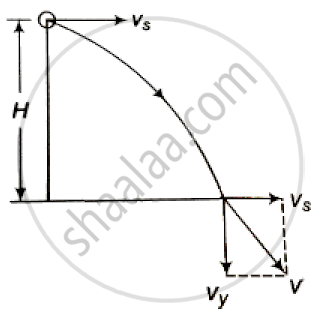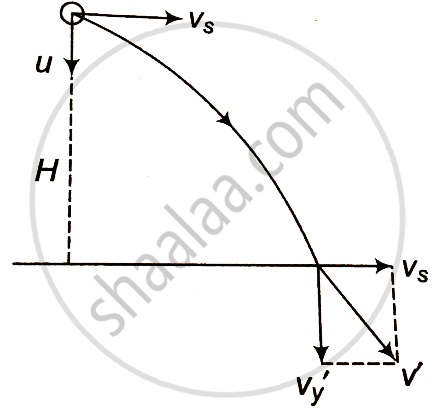Advertisements
Advertisements
Question
A cricket bowler releases the ball in two different ways
- giving it only horizontal velocity, and
- giving it horizontal velocity and a small downward velocity. The speed vs at the time of release is the same. Both are released at a height H from the ground. Which one will have greater speed when the ball hits the ground? Neglect air resistance.
Solution
a. When a ball is given only horizontal velocity at the time of release (ux) = vs
During projectile motion. horizontal velocity remains unchanged,
Therefore, vx = ux = vs
In vertical direction, `v_y^2 = u_y^2 + 2gH`
`v_y = sqrt(2gH)` .....(∵ uy = 0)

∴ Resultant speed of the ball at the bottom,
`v = sqrt(v_x^2 + v_y^2)`
= `sqrt(v_s^2 + 2gH)` ......(i)
b. When the ball is given horizontal velocity and a small downward velocity

Let the ball be given a small downward velocity u.
In horizontal direction `v_x^' = u_x = v_s`
In vertical direction `v_y^2 = u^2 + 2gH`
or `v_y^' = sqrt(u^2 + 2gH)`
∴ Resultant speed of the ball at the bottom
`v^' = sqrt(v_x^2 + v_y^2)`
= `sqrt(v_s^2 + u^2 + 2gH)` ......(ii)
From equations (i) and (ii), we get v' > v
APPEARS IN
RELATED QUESTIONS
Give the magnitude and direction of the net force acting on a cork of mass 10 g floating on water.
Give the magnitude and direction of the net force acting on a kite skillfully held stationary in the sky.
Give the magnitude and direction of the net force acting on a high-speed electron in space far from all material objects, and free of electric and magnetic fields.
A pebble of mass 0.05 kg is thrown vertically upwards. Give the direction and magnitude of the net force on the pebble,
- during its upward motion,
- during its downward motion,
- at the highest point where it is momentarily at rest. Do your answers change if the pebble was thrown at an angle of 45° with the horizontal direction? Ignore air resistance.
Give the magnitude and direction of the net force acting on a stone of mass 0.1 kg, just after it is dropped from the window of a stationary train. Neglect air resistance.
Give the magnitude and direction of the net force acting on a stone of mass 0.1 kg, just after it is dropped from the window of a train running at a constant velocity of 36 km/h. Neglect air resistance.
Give the magnitude and direction of the net force acting on a stone of mass 0.1 kg, just after it is dropped from the window of a train accelerating with 1 m s–2. Neglect air resistance.
Give the magnitude and direction of the net force acting on a stone of mass 0.1 kg, lying on the floor of a train which is accelerating with 1 m s–2, the stone being at rest relative to the train. Neglect air resistance.
In figure, a body A of mass m slides on plane inclined at angle θ1 to the horizontal and µ1 is the coefficent of friction between A and the plane. A is connected by a light string passing over a frictionless pulley to another body B, also of mass m, sliding on a frictionless plane inclined at angle θ2 to the horizontal. Which of the following statements are true?
- A will never move up the plane.
- A will just start moving up the plane when `µ = (sin θ_2 - sin θ_1)/(cos θ_1)`
- For A to move up the plane, θ2 must always be greater than θ1.
- B will always slide down with constant speed.

The velocity of a body of mass 2 kg as a function of t is given by `v(t) = 2t hati + t^2hatj`. Find the momentum and the force acting on it, at time t = 2s.
